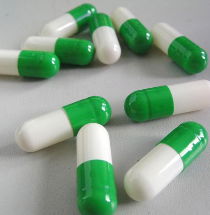| Model: | capsule |
|---|---|
| Brand: | CP2020 |
| Origin: | Made In China |
| Category: | Chemicals / Pharmaceutical Chemicals |
| Label: | Succimer 250mg , DMSA , lead removal |
| Price: |
US $80
/ Unit
|
| Min. Order: | 5 Unit |
Product Description
Succimer Capsule 250 mg DESCRIPTION DMSA (succimer) is an orally active, heavy metal chelating agent. The chemical name for succimer is meso 2, 3-dimercaptosuccinic acid (DMSA). Its empirical formula is C4H6O4S2 and molecular weight is 182.2.
Succimer is a white crystalline powder with an unpleasant, characteristic mercaptan odor and taste. Each DMSA opaque white capsule for oral administration, contains beads coated with 250 mg of succimer . Inactive ingredients in medicated beads are: povidone, sodium starch glycolate, starch and sucrose. Inactive ingredients in capsule are: gelatin, iron oxide, titanium dioxide and other ingredients.
CLINICAL PHARMACOLOGY Succimer is a lead chelator; it forms water soluble chelates and, consequently, increases the urinary excretion of lead. Preclinical Toxicology: Succimer has low acute oral toxicity, with oral median lethal doses in rodents in excess of 3.6 g/kg. In a 28-day toxicity study, dogs receiving 30 and 100 mg/kg/day had lower urinary specific gravity and an increase in renal tubular regenerative hyperplasia. No renal toxicity was noted in dogs given 50 mg/kg/day orally for 14 consecutive days. In a chronic 6-month oral toxicity study, one male dog died (out of 7) at a dose of 200 mg/kg/day attributed to associated renal toxicity. Treatment related renal tubule epithelial changes in this study were observed in dogs after chronic (6-month) exposure to 110 and 200 mg/kg/day for 17 days then to 80 and 140 mg/kg/day for the remainder of the study. These changes were dose-dependent and correlated with increased kidney weights in male and female dogs at the 10 mg/kg/day dose. Nephropathy was not observed in dogs treated at 10 mg/kg/day. Reduced platelet counts were noted in 5 of 7 dogs receiving either 80 or 140 mg/kg/day for 3 or 6 months, although group means were not statistically different from concurrent controls. Platelets had not been quantified in earlier studies. Normal megakaryocytes in the bone marrow, plus the absence of fibrin degradation products or histologic evidence for DIC, s ested an autoimmune-mediated thrombocytopenia, a finding common in dogs but not in other species. However, serum antibody tests were inconclusive. Rats dosed chronically to 500 mg/kg/day developed no evidence for nephropathy orthrombocytopenia.?
Other Heavy Metal Poisoning: No controlled clinical studies have been conducted with DMSA in poisoning with other heavy metals. A limited number of patients have received DMSA for mercury or arsenic poisoning. These patients showed increased urinary excretion of the heavy metal and varying degrees of symptomatic improvement.
INDICATIONS AND USAGE DMSA is indicated for the treatment of lead poisoning in pediatric patients with blood lead levels above 45 mcg/dL. DMSA is not indicated for prophylaxis of lead poisoning in a leadcontaining environment; the use of DMSA should always be accompanied by identification and removal of the source of the lead exposure.
CONTRAINDICATIONS DMSA should not be administered to patients with a history of allergy to the drug.
?WARNINGS
Keep out of reach of pediatric patients. DMSA is not a substitute for effective abatement of lead exposure. Mild to moderate neutropenia has been observed in some patients receiving DMSA. While a causal relationship to DMSA has not been definitely established, neutropenia has been reported with other drugs in the same chemical class. A complete blood count with white blood cell differential and direct platelet counts should be obtained prior to and weekly during treatment with DMSA. Therapy should either be withheld or discontinued if the absolute neutrophil count (ANC) is below 1200/mcL and the patient followed closely to document recovery of the ANC to above 1500/mcL or to the patient’s baseline neutrophil count. There is limited experience with reexposure in patients who have developed neutropenia. Therefore, such patients should be rechallenged only if the benefit of DMSA therapy clearly outweighs the potential risk of another episode of neutropenia and then only with careful patient monitoring. Patients treated with DMSA should be instructed to promptly report any signs of infection. If infection is suspected, the above laboratory tests should be conducted immediately.
PRECAUTIONS The extent of clinical experience with DMSA is limited. Therefore, patients should be carefully observed during treatment.
General: Elevated blood lead levels and associated symptoms may return rapidly after discontinuation of DMSA because of redistribution of lead from bone stores to soft tissues and blood. After therapy, patients should be monitored for rebound of blood lead levels, by measuring blood lead levels at least once weekly until stable. However, the severity of lead intoxication (as measured by the initial blood lead level and the rate and degree of rebound of blood lead) should be used as a guide for more frequent blood lead monitoring. All patients undergoing treatment should be adequately hydrated. Caution should be exercised in using DMSA therapy in patients with compromised renal function. Limited data s ests that DMSA is dialyzable, but that the lead chelates are not. Transient mild elevations of serum transaminases have been observed in 6-10% of patients during the course of DMSA therapy. Serum transaminases should be monitored before the start of therapy and at least weekly during therapy. Patients with a history of liver disease should be monitored closely. No data are available regarding the metabolism of DMSA in patients with liver disease. Clinical experience with repeated courses is limited. The safety of uninterrupted dosing longer than three weeks has not been established and it is not recommended. The possibility of allergic or other mucocutaneous reactions to the drug must be borne in mind on readministration (as well as during initial courses). Patients requiring repeated courses of DMSA should be monitored during each treatment course. One patient experienced recurrent mucocutaneous vesicular eruptions of increasing severity affecting the oral mucosa, the external urethral meatus and the perianal area on the third, fourth and fifth courses of the drug. The reaction resolved between courses and upon discontinuation of therapy.??Information for Patients: Patients should be instructed to maintain adequate fluid intake. If rash occurs, patients should consult their physician. Patients should be instructed to promptly report any indication of infection, which may be a sign of neutropenia (see WARNINGS and ADVERSE REACTIONS).
In young pediatric patients unable to swallow capsules, the contents of the capsule can be administered in a small amount of food (see DOSAGE AND ADMINISTRATION). Drug Interaction: DMSA is not known to interact with other drugs including iron supplements; interactions have not been systematically studied. Concomitant administration of DMSA with other chelation therapy, such as CaNa2EDTA is not recommended. Drug/Laboratory Tests Interaction: DMSA may interfere with serum and urinary laboratory tests. In vitro studies have shown DMSA to cause false positive results for ketones in urine using nitroprusside reagents such as Ketostix* and falsely decreased measurements of serum uric acid and CPK. *Ketostix is a registered trademark of Bayer Diagnostics. Carcinogenesis, Mutagenesis and Impairment of Fertility: DMSA has not been tested for carcinogenic potential in long-term animal studies. Succimer up to a dose of 510 mg/kg/day in males and 100 mg/kg/day in females did not show any adverse effect on fertility and reproductive performance. It was not mutagenic in the Ames bacterial assay and in the mammalian cell forward gene mutation assay. Pregnancy: Succimer has been shown to be teratogenic and fetotoxic in pregnant mice when given subcutaneously in a dose range of 410 to 1640 mg/kg/day during the period of organogenesis. In a developmental study in rats, succimer produced maternal toxicity and deaths at the dose of 720 mg/kg/day or more during organogenesis. The dose of 510 mg/kg/day was the highest tolerable dose in pregnant rats. Impaired development of reflexes was noted in pups of 720 mg/kg/day group dam. There are no adequate and well controlled studies in pregnant women. DMSA should be used during pregnancy only if the potential benefit justifies the potential risk to the fetus. Nursing Mothers: It is not known whether this drug is excreted in human milk. Because many drugs and heavy metals are excreted in human milk, nursing mothers requiring DMSA therapy should be discouraged from nursing their infants. Pediatric Use: Refer to the INDICATIONS and DOSAGE AND ADMINISTRATION sections. Safety and efficacy in pediatric patients less than 12 months of age have not been established.?
ADVERSE REACTIONS Clinical experience with DMSA has been limited. Consequently, the full spectrum and incidence of adverse reactions including the possibility of hypersensitivity or idiosyncratic reactions have not been determined. The most common events attributable to DMSA, i.e., gastrointestinal symptoms or increases in serum transaminases, have been observed in about 10% of patients (see PRECAUTIONS). Rashes, some necessitating discontinuation of therapy, have been reported in about 4% of patients. If rash occurs, other causes (e.g. measles) should be considered before ascribing the reaction to DMSA. Rechallenge with DMSA may be considered if lead levels are high enough to warrant retreatment. Allergic reactions including urticaria and angioedema have been reported on repeated administration of the drug (see PRECAUTIONS). Mild to moderate neutropenia has been observed in some patients receiving DMSA (see WARNINGS).
OVERDOSAGE Doses of 2300 mg/kg in the rat and 2400 mg/kg in the mouse produced ataxia, convulsions, labored respiration and frequently death. No case of overdosage has been reported in humans. Limited data indicate that DMSA is dialyzable. In case of acute overdosage, induction of vomiting or gastric lavage followed by administration of an activated charcoal slurry and appropriate supportive therapy are recommended.?
DOSAGE AND ADMINISTRATION Start dosage at 10 mg/kg or 350 mg/m2 every eight hours for five days. Initiation of therapy at higher doses is not recommended. Reduce frequency of administration to 10 mg/kg or 350 mg/m2 every 12 hours (two-thirds of initial daily dosage) for an additional two weeks of therapy. A course of treatment lasts 19 days. Repeated courses may be necessary if indicated by weekly monitoring of blood lead concentration. A minimum of two weeks between courses is recommended unless blood lead levels indicate the need for more prompt treatment
One unit contains 50capsules of 250mg DMSA.
| Price Terms: | FOB CHINA |
|---|---|
| Payment Terms: | TT/PAYPAL |
| Packing: | EXPORT PACKING |
| Lead Time: | WITHIN 3 DAYS AFTER PAYMENT |
| Standards Certificate: | CP2020 |
| Specifications: | Succimer Capsule 2500 mg DESCRIPTION DMSA (succimer) is an orally active, heavy metal chelating agent. The chemical name for succimer is meso 2, 3-dimercaptosuccinic acid (DMSA). Its empirical formula is C4H6O4S2 and molecular weight is 182.2. Succimer is a white crystalline powder with an unpleasant, characteristic mercaptan odor and taste. Each DMSA opaque white capsule for oral administration, contains beads coated with 250 mg of succimer . Inactive ingredients in medicated beads are: povidone, sodium starch glycolate, starch and sucrose. Inactive ingredients in capsule are: gelatin, iron oxide, titanium dioxide and other ingredients. |
Member Information
| YoungCom Biotech Limited | |
|---|---|
| Country/Region: | Guang Dong - China |
| Business Nature: | Trading Company |
| Phone: | 26879710 |
| Contact: | Sales Dept., (Sales) |
| Last Online: | 07 Aug, 2024 |



